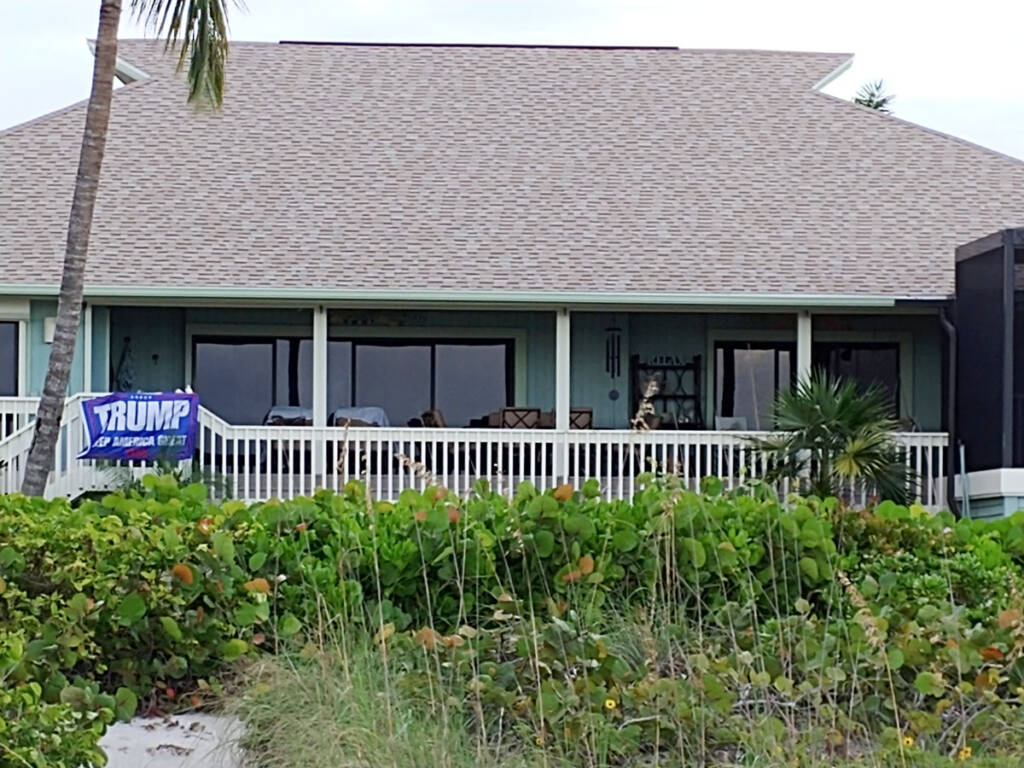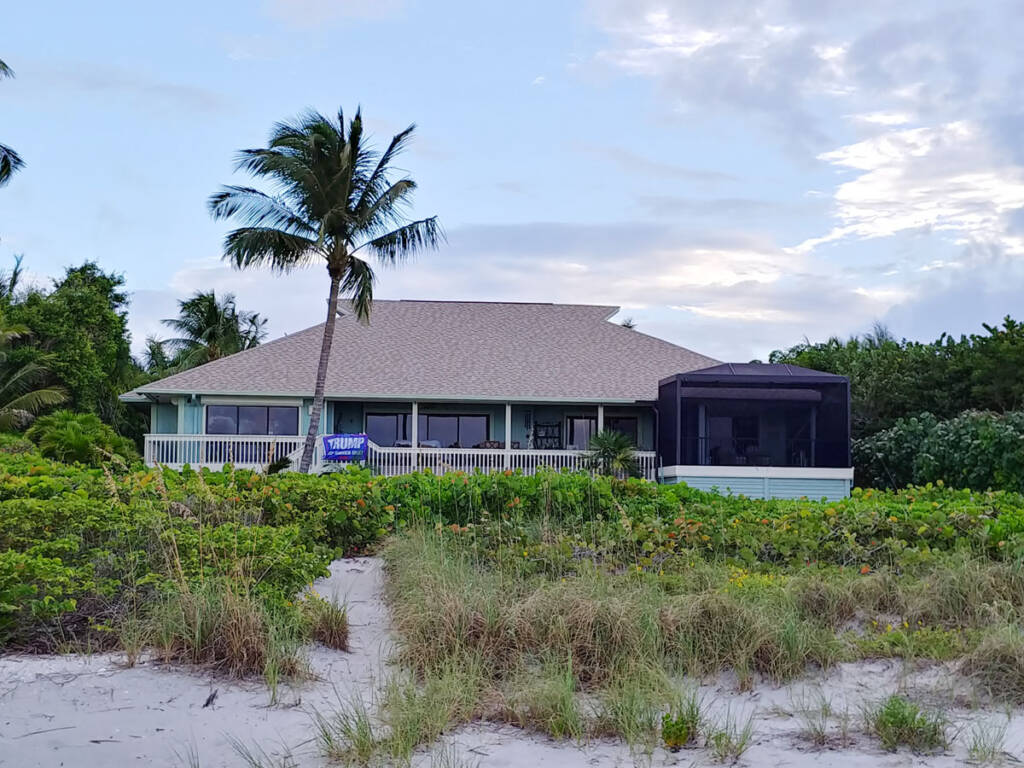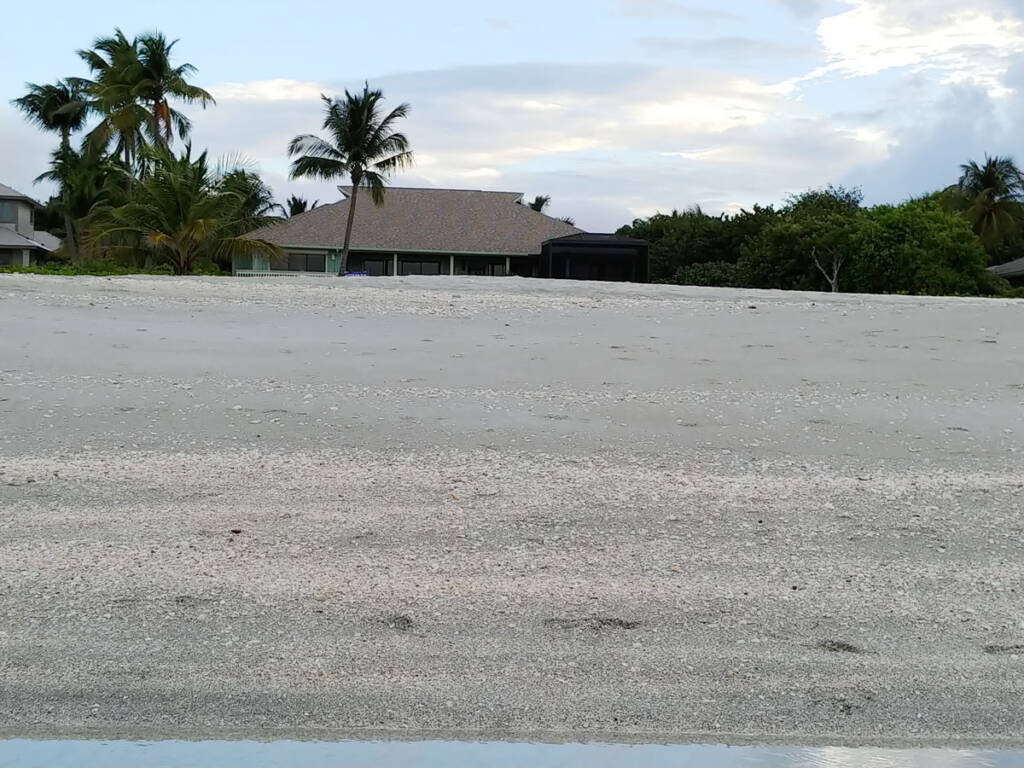
I’ve learned to ignore Trump 2020 signage and those who display them. It’ll drive you crazy otherwise.
More than 40 percent of the country will vote for a dangerous incompetent for reasons that make twisted sense (for the rich, low taxes and regulatory rollbacks; for the not-rich, abortion-opposing/religious-leaning conservative judges and a misguided notion that Trump would somehow stop black and brown people from overtaking “whites without college degrees” in the national hierarchy) and no sense at all (a vague belief in “keeping America great”; a conviction that Biden is a “socialist” who will somehow, despite the Second Amendment, take away their guns).
But one such Trump sign, hanging from the balcony of a multimillion-dollar house on the southern coast of Sanibel Island, Florida, did catch my attention. I was running on the beach at the time. The sign – a blue number with a simple “TRUMP: KEEP AMERICA GREAT” – hung from a house that Trump’s reelection would put at risk.
My first question was why hang such a sign facing the Gulf of Mexico? Perhaps the mad shellers of Sanibel are a species as rare as the coveted junonia shell: undecided voters in the 2020 presidential election. Or maybe the hanger of this sign was attempting to sway the dolphin-and-pelican demographic toward his (or her, but probably his) preferred candidate. Either way, as with so many Trump signs, it serves primarily a badge of ignorance – even ore so on this residence.
Sanibel Island is essentially a pile of shells that reaches nine feet only in the J. N. “Ding” Darling National Wildlife Refuge. Native Americans called the Calusa somehow lived in this mangrove swamp for centuries, and their piles of used shells (these people used shells for everything) and other detritus, collectively called middens, rise to about that height.
The multimillion-dollar house was not built on a midden. I would put it at maybe five-six feet above sea level, which is about as high as anything else on Sanibel Island gets.
Trump threatens this home and many others (including his own at Mar-a-Lago in Palm Beach) through his blithe disregard for climate change and his unwillingness to address it. The list of his sins in this regard is long, including wholehearted support of the coal industry (which is shrinking, thankfully, despite him), the oil and gas industry, and about every industry that emits great wafts of carbon dioxide, methane, or other forms of carbon pollution. Trump rolled back automotive fuel efficiency standards the auto industry itself support; Trump pulled the United States out of the Paris Climate Accords; Trump wants showers and dishwashers to use more, not less energy. (Columbia University researchers have catalogued more than 160 significant rollbacks of environmental regulations by his administration.)
The problems on Sanibel will start long before the Gulf of Mexico rises enough to soak the of ankles of this fancy’s house’s Trump banner. Sea level has risen “only” about three inches around Florida since 2000, yet tidal flooding around the state is up by 352%.
A peer-reviewed report published in May estimates that, if the planet warms another 3.5 degrees Celsius (6.3 degrees Fahrenheit, which is unfortunately not a worst-case scenario), average global sea level will rise by 1.3 meters (4.27 feet) by 2100. Now, anyone hanging a Trump sign on a multimillion-dollar house will be dead by then, but his (let’s go with “his”) grandchildren won’t be.

That same report looks even further ahead, to the year 2300. This sounds like a million years from now, but 2300 will be to 2020 what 2020 is to 1740. That’s recent history in the great sweep of civilization. By 2300, global sea level would be about five meters higher than today under that temperature scenario. Five meters is 16.4 feet.
Many of the Founding Fathers were boys and young men in 1740. Where would we be had they been as shortsighted as this wealthy dude hanging his Trump 2020 sign for the dolphins and pelicans and me? And it’s not just the distant progeny of some rich guy on Sanibel Island to be concerned about. Globally, some 770 million people live on land less than five meters above sea level.
As an aside, these sea-level-rise estimates are bound to keep climbing as they’ve done for years now. The 2020 estimates above are 60% higher than the ones published in the IPCC’s Fifth Assessment Report in 2014. When I wrote about the Fourth Assessment Report while covering climate change for the Boulder Daily Camera in 2007, the 2100 sea-level-rise estimate for a much worse emissions scenario was more like two feet.
Why? Scientists are a conservative lot when it comes to interpreting data, and back then, the behavior of the Greenland and Antarctic ice sheets was so poorly understood that the climate models only accounted for thermal expansion of the water itself. Now we see Greenland melting like mad and West Antarctica in hot pursuit, the ice shelves buttressing the latter’s glaciers breaking away and swimming off into the Southern Ocean at an alarming rate. Those glaciers could then flow into the sea like wine uncorked.
Trump is just one man, of course, but he arrived in power at a moment when our emissive profligacy is at a crossroads, and he’s the wrong man at the wrong time.
As Penn State climate scientist Michael Mann recently put it, “If we are going to avert ever more catastrophic climate change impacts, we need to limit warming below a degree and a half Celsius, a little less than three degrees Fahrenheit,” he said. “Another four years of what we’ve seen under Trump, which is to outsource environmental and energy policy to the polluters and dismantle protections put in place by the previous administration … would make that essentially impossible.”
Mann referred to the IPCC’s 2018 report that dialed back the previous red line of warming the planet by two degrees Celsius (3.6 F) over preindustrial levels to 1.5 degrees Celsius (2.7 F). That report estimated that we had to cut greenhouse-gas emission by 50% by 2030 to have a shot at keeping the increase at 1.5 degrees. (We’ve already warmed the planet a degree Celsius since the Industrial Revolution began, with 20 percent of that increase having happened since 2010.)
“Four more years of relative inaction, of flat emissions, means that four years from now that [5% annual emissions-reduction] number might be closer to 15% a year,” Mann told The Guardian. “And that may be, although not physically impossible, societally impossible.”

While a lovely house on Sanibel Island will attract buyers for quite a while yet, the real estate market has not been as blind to future sea level rise as this palace’s owner seems to be. University of Pennsylvania Wharton School researchers Benjamin Keys and Philip Munder found that the sales of homes in places vulnerable to sea level rise to have fallen relative to those higher up or farther inland – a trend that became noticeable in 2013. By 2020, homes with greater exposure to rising seas were selling at 5% to 10% discount as compared to those in safer havens.
The Union of Concerned Scientists would also argue that Sanibel Island homeowners such as this Trump acolyte should indeed be concerned. Researchers there built an online model showing high- and low-emissions scenarios impact on sea levels down to the zip code level. In Sanibel 33957, the low-emissions scenario (in which atmospheric CO2 rises for a few more years, levels off, and then falls), 140 homes are at risk of chronic inundation by 2035 – that’s just 15 years from now – and 5,231 homes are at similar risk by 2100 – about 60% of the island’s total.
Under the higher-emissions scenario –one we’re on track to blast right through with a continuation of Trumpian climate policy – 506 Sanibel homes get flooded out by 2035 and 6,988 do by 2100 – the latter amounting to 81% of the existing housing stock. That would be $4.5 billion in mostly high-end real estate lost to the drink.
This all assumes that saltwater encroachment, storm surges, a global-warming-bolstered hurricane or whatever else don’t take them out well before that. Sanibel Island is a beautiful, unique place, one appreciated and beloved by and by the Calusas for many centuries before we showed up. Unless we change course, we risk erasing Sanibel and countless other places just as beloved by those alive now and those long gone. Should we continue as we are, we will deprive those just a few generations behind us of what should be theirs, too.
People have their reasons for voting for Trump. My suspicion is that the owner of this house and this sign are doing so for the simple reason that they think Trump is good for his bank account. On Sanibel Island and around the coast of the rest of Florida, that’s bet’s all wet.
